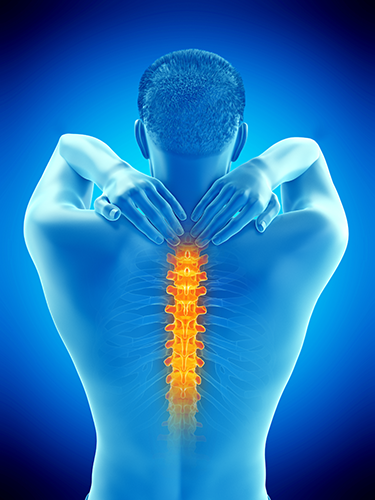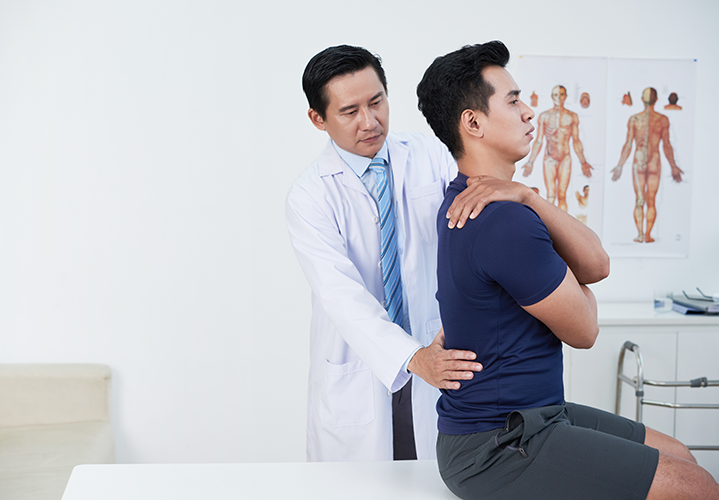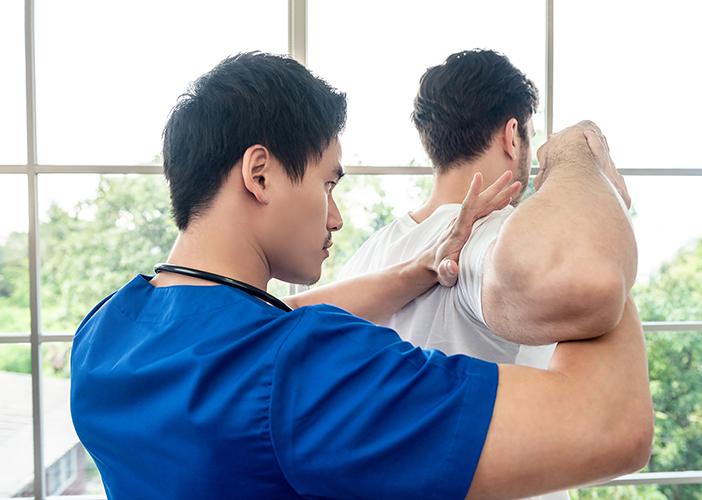Knowledge Center
Getting Pain Off Your Upper Back
The upper back or the thoracic spine is the region below the neck and the bottom of the ribcage.
It keeps us upright, protects the spinal cord, anchors the ribs that secure vital organs, and serves as attachment points for muscles that allow us to move.
It supports the load of the upper body with the help of nearby muscles like the trapezius, latissimus dorsi, and rhomboids.1,2,3



Although upper back pain is less common than lower back pain, it should not be neglected so it can continue to fulfill its many functions optimally.
Here is a guide on the common causes, prevention, and treatments so you can be stronger than upper back pain.
Why Is There Upper Back Pain?
When you feel aching, tightness, stiffness, tenderness to touch, sharp stabs, or burning pains, these are usually symptoms of musculoskeletal strain.1
These can mean that the muscles, tendons, or bones in the upper back are involved, and are usually due to the following causes:

- Herniated discs - This condition is more common in the lower back but may occur in the upper back too. Discs are soft, rubbery cushions that act as shock absorbers between each vertebra or bone in the spine. When a piece of this cushion pokes through, the bones would grind against each other, put pressure on the spine, and cause pain.5
- Pinched nerve - This happens when a herniated disc slips and compresses the nearby nerve causing numbness and pain in the arms or legs, problems with controlling urination, and loss of control in the legs.4,5
- Osteoarthritis - A painful condition where the bones rub together because the cartilage that cushions the bones has worn down.2
- Myofascial pain - Pain and inflammation in the body's soft tissues may also occur in the upper back.2
Breaking Bad Back Habits
Since most causes of upper back pain are lifestyle factors and repetitive behavior, you can change everyday habits to avoid pain.


- Excess weight in the midsection or belly area puts unnecessary stress on the upper back.
- Smoking can cause degenerative disc disease, restricts nutrients from reaching the back and discs, and slows down the healing process.1,2,4
How to be Stronger Than Upper Back Pain
Recommended treatments for upper back pain depend on what you feel.


For acute pain
or sharp and sudden pain caused by something specific, you can try:
-
To rest or slow down
Allowing time for the muscles to recover and decreasing the intensity of exercises or modifying repetitive activities can help address muscle pain. Too much bed rest may cause the muscles to weaken so the balance of rest and activity is key.2,6
-
Home remedies
Applying ice for pain and swelling, or heat for impaired mobility and stiffness are tried and tested first aid techniques.1,2,6
Perskindol Classic, a topical aid, has dual thermal action of cold and heat therapy for musculoskeletal pain. It uses cold therapy to reduce swelling and heat therapy to give pain relief.
-
Getting a massage
This provides temporary relief from upper back pain by loosening tight muscles and allowing more circulation.2,7
Massaging Perskindol Classic in the painful area can be beneficial especially because it has the essence of natural ingredients and works just like aromatherapy.
For chronic pain or pain that lasts or lingers even after an injury or illness has healed, you should:
-
See a doctor for proper diagnosis
When upper pain persists for weeks or months, doesn’t improve with rest, spreads down the limbs, causes weakness, numbness, or tingling on one or both legs, and is accompanied by unexplained weight loss, it is best to get tested and treated by medical professionals.2,4,6
In the long run, a healthy and active lifestyle is still the best way to avoid upper back pain.
Keep Perskindol Classic handy for fast muscle pain relief whenever you are doing physically demanding exercises and tasks.
Finally, being aware of the different risk factors and kinds of upper back pain is helpful in determining whether you can power through the pain and knowing when it’s time to ask for medical help.
For more information, please consult your physician or pharmacist.
The information in this article is not country-specific and may contain information that is outside the approved indications in your country.Available at: https://www.who.int/news-room/fact-sheets/detail/physical-activity accessed on Apr 2023.
2. Cirino E. Healthline. 8 Calisthenics exercises for beginners. Medical reviewed by Bubnis D. Updated Apr 2017.
Available at: https://www.healthline.com/health/fitness-exercise/calisthenics accessed on Apr 2023.
3. WebMD. Calories Burned by Household Chores. Medical reviewed by Mikstas C. Updated Nov 2021.
Available at: https://www.webmd.com/fitness-exercise/ss/slideshow-calories-burned-by-household-chores accessed on Apr 2023.
4. National Aeronautics and Space Administration. Desk fit: 20 essential desk exercises you can do without leaving your office or home workspace.
Available at: https://www.nasa.gov/sites/default/files/atoms/files/hq_deskfit_booklet_6.10.2020.pdf accessed on Apr 2023.
5. Mayo Clinic. Aerobic exercise: how to warm up and cool down. Updated Oct 2021.
Available at: https://www.mayoclinic.org/healthy-lifestyle/fitness/in-depth/exercise/art-20045517#:~:text=A%20warmup%20gradually%20revs%20up,heart%20rate%20and%20blood%20pressure accessed on Apr 2023.



